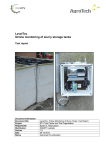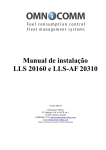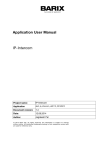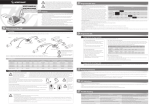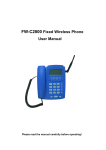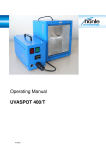Download Omnicomm PROFI terminal
Transcript
Omnicomm PROFI terminal «Solid Systems» LLC RA. Yereva., 0048, H.Beknazarjan 5/7 st. E-mail: [email protected] www.omnicomm.am TABLE OF CONTENTS 1. INTRODUCTION ............................................................................................................................4 2. DESCRIPTION AND OPERATION ....................................................................................................4 2.1. MODIFICATIONS OF OMNICOMM PROFI TERMINAL ...............................................................4 2.2. PURPOSE OF OMNICOMM TERMINALS ....................................................................................4 2.3. TECHNICAL SPECIFICATIONS ..................................................................................................4 2.4. FUNCTIONS, CONSTRUCTION AND PRINCIPLE OF OPERATION ...............................................7 2.4.1. FUNCTIONS OF OMNICOMM TERMINAL ............................................................................7 2.4.2 CONSTRUCTION OF OMNICOMM PROFI TERMINAL ......................................................... ..9 2.4.3 PRINCIPLE OF OPERATION .............................................................................................. 10 2.4.4. Omnicomm terminal LEDs .................................................................................................. 14 2.4.5. PARAMETERS DETERMINIG THE TRAFFIC VOLUME ........................................................ 15 2.4.6. PRINCIPLE OF OPERATION OF THE UNIVERSAL INPUTS OF Omnicomm terminal .............. 15 2.5. MARKING .............................................................................................................................. 18 3. INTENDED USE ............................................................................................................................ 18 3.1. OPERATING LIMITS ............................................................................................................... 18 3.2. PREPARATION FOR USE ........................................................................................................ 19 3.3. TYPES OF OPTIONAL EQUIPMENT THAT CAN BE CONNECTED TO OMNICOMM PROFI TERMINAL................................................................................................................................... 19 3.4. USE OF THE UNIT .................................................................................................................. 20 3.4.1. DRIVER USER .................................................................................................................. 20 3.4.2. FUNCTIONS PERFORMED BY THE USER ........................................................................... 21 4. MAINTENANCE ............................................................................................................................ 21 5. ROUTINE REPAIR ......................................................................................................................... 22 APPENDIX A.................................................................................................................................... 22 APPENDIX B .................................................................................................................................... 23 2 ABBREVIATIONS AND DEFINITIONS PC – personal computer. SW – software. VH – vehicle. GPS (Global Positioning System) – Global Satellite Navigation System of the USA. GSM (Groupe Spécial Mobile) – global digital standard for mobile cellular communication. GPRS (General Package Radio Service) – GSM mobile communication add-on technology for package data transmission. GPRS allows the cellular network user to exchange data with other GSM network devices and external networks, including the Internet. Home network – area within which it is possible to use the services of a given operator without using roaming services. Roaming - procedure for providing cellular services to the subscriber outside the subscriber’s home network coverage area by using the network resources of another mobile operator. Communication server (CS) – server located in the territory of Omnicomm that collects and stores data from the vehicle onboard equipment and transmits data to Omnicomm SW. Omnicomm Autocheck SW – server used to analytically process data received from the CS and the LCS and report on received and processed data. iButton – set of devices for identification of drivers. 3 1. INTRODUCTION This operation manual describes the construction, principle of operation and operating procedures of Omnicomm Profi terminal. 2. DESCRIPTION AND OPERATION 2.1. MODIFICATIONS OF OMNICOMM PROFI TERMINAL Omnicomm Profi terminal is equipped with the unit compatible with GPS satellite systems. Modifications of Omnicomm terminals differ by their design and the type of equipment to be connected. Modification-specific functions and technical specifications of Omnicomm terminals are described below. 2.2. PURPOSE OF OMNICOMM TERMINALS Omnicomm terminals are designed to operate with Omnicomm monitoring system, as well as with the third party vehicle monitoring systems. 2.3. TECHNICAL SPECIFICATIONS Specification Value Comments General Overall dimensions, mm 127.5x100.5x38.0 Operating temperature, °C IP51 (when cables are mounted into corrugation) / IP41(when rubber cable glands are used) -40 to +60 Front panel indication LED Operating mode Power supply and power consumption continuous Ingress protection rating Normal operation range, V Total operating range, V Power consumption for different data collection modes, W, not more than collect data during pounding; +7 to +60 1.0 2.0 collect all data. 3.0 Voltage of integrated power supply, V Load current of built-in power supply, mA, not more than Built-in backup battery Data collection Data collection period Archive capacity, records, not more than 4 LEDs, see par. 3.3 40 to +60 collect data, except GPS; Power consumption of the internal heater, W W/o connected cable connectors and wires. Excluding power supply of LLS sensors, internal heater operation and battery charge current. 3 to 11, when supply voltage is 10 to 32 V, respectively 12±0.5 The heater is activated when the temperature falls below -10°C. 350 Built-in short circuit protection with self- restoring capacity. Li type Runtime not less than 8 hours in standby mode For power supply of LLS sensors and external devices. 15 to 3600 s Set-up during installation 100,000 Depending on the number of collected parameters 4 Built-in peripherals Real-time clock Accelerometer Temperature sensor The time calculation error in standalone mode is not more than ±5 min. per year(when disconnected from GPS) Three-axis, measurement limit up to ±8 g. Absolute measurement error ±1°C. 1Wire bus controller Data transmission channel GSM/GPRS + With stand-alone power supply. Automatic adjustment based on the GPS signal. For connection of iButton external reader. 850/900/1800/1900 MHz Interfaces RS-485 LLS Data rate 19,200 bps RS-485 TS Data rate 115,200 bps USB CAN 2.0 Contact or contactless connection to the vehicle electrical system. Voice communication + For connection LLS 20160, LLS 20230 sensors. For digital camera connection. For PC connection and setup of terminal For connection of the external voice communication headset and speakers. Discrete inputs Ignition key Alarm button Call answering input Potential, actuation voltage not less than 8 V. Actuated if the VH is shorted to ground, with internal uncontrolled tightening to power plus. Actuated if the VH is shorted to ground, with internal uncontrolled tightening to power plus From ignition switch. From alarm button. On the voice communication headset or as a separate button. Pulse inputs Velocity Engine speed Universal inputs Number of universal inputs Connected signals Frequency-modulated signal, input signal frequency 10 Hz to 100 kHz, signal amplitude not less than 5 V. Frequency-modulated signal, input signal frequency 10 Hz to 5 kHz, signal amplitude not less than 5 V. From pulse velocity sensor. From generator, tachograph or pulse sensor. 4 Analogue voltage signal, pulse signal, potential signal. The signal type is programmable, connection is made via the same wire Analogue signal: Input voltage range Measurement resolution Basic percentage error limit Measurement rate 0 to 30 V 10 bits ±1% 1s Pulse signal: Pulse frequency Minimum unit pulse duration Input signal amplitude 10 Hz to 10 kHz 1 μs not less than 5 V Potential signal: Actuation determination voltage limit Programmable within the range of 1 to30 V. Actuation (logical unit recording) takes place during data collection if the input voltage exceeds the actuation threshold. 5 Minimum duration of existing voltage that exceeds the threshold for actuation recording Discrete outputs Sound signal Freely controlled discrete output 100 μs Supply voltage to output switching, switching current up to 300 mA. Supply voltage to output switching, switching current up to 300 mA For connection of the sound source. Controlled by incoming SMSmessages GPS global positioning system Systems in use GPS together, 32 channels Positioning accuracy, m up to 3 Cold start, s not more than 60 Hot start, s not more than 15 Type of antenna external, SMA connector Antenna mounting technique to metal surfaces using the built-in magnet and additionally glued Depending on the number of visible satellites. Depending on the number of visible satellites. Positioning period upon startup. Positioning period upon short shutdown. To be only installed onto the VH roof or uncovered horizontal surfaces. Note: The following is supplied optionally: o alarm button*; o iButton kit for driver identification (iButton reader, four iButton keys and sound source)*; o external backup battery complete with a special card; o voice communication kit: headset and speaker; o sound source*; o mini USB – USB cable; o CAN alligator clip; o digital camera. * It is recommended to purchase these items from Omnicomm. For detailed description see Appendix B 6 2.4. FUNCTIONS, CONSTRUCTION AND PRINCIPLE OF OPERATION 2.4.1. FUNCTIONS OF OMNICOMM TERMINAL Omnicomm Profi 1. Measurement of location (spatial coordinates), altitude and velocity of the VH. 2. Data collection from the VH at a preset interval, namely: o data from 6 LLS 20160 or LLS 20230 fuel level sensors (fuel level, LLS sensors status, LLS sensors temperature) o data from 4 universal inputs; o data from iButton reader; o velocity data from pulse velocity sensor or from CAN bus; o data from digital camera; event registration time; ignition key status; engine speed values from pulse sensor or from CAN bus or based on the ignition key position; system voltage; Alarm button input status; acceleration values; data from CAN bus*. 2. Collection of additional location data during turns and slow turns. 3. Data transmission optimization when in home network or roaming. 4. Selection of the data collection and transmission mode when the ignition key is in off position: Collect all data (with data transmission at intervals preset in terminal). Collect all data, except GPS (with data transmission once an hour in home network and once a day in roaming). Collect data during 5 minutes if accelerometer readings change by 0.2g, with subsequent transmission. 5. Data transmission when the alarm button is pressed. 6. Conversion of data (from engine speed sensor, pulse velocity sensor, pulse universal inputs) to physical values based on calibration and configuration factors. 7. Data reading and conversion to physical values of CAN bus data selected by the user during configuration. 8. Data storage in the internal non-volatile memory before data transmission to the CS. 9. Additional filtration of data from LLS sensors. 10. Sound source control through SMS. 11. Control of general-purpose digital output through SMS-messages. 12. Control of driver identification. 13. Control of internal heating of SIM card. 14. Recording and transmission of the following data to be displayed in Omnicomm Configurator SW, in addition to the parameters listed above: Time values of the built-in clock. Time values of the GPS system. Internal temperature of the unit. Voltage and number of pulses at pulse and universal inputs. 15. Processing of incoming and outgoing phone voice calls. 16. Adjustment of internal time based on the GPS data. 17. Two-color LED indication of unit statuses and terminal power supply. 18. Processing of incoming SMS. 19. Parameter settings and firmware update via USB interface and via the CS based on the GPRS data. 20. Calculation of mileage based on the GPS data. 7 * Data from CAN bus: temperature of the engine coolant; pressure and temperature of the engine oil; accelerator pedal position [%]; cruise control status; state and position of the foot brake (pedal); engine speed [rpm]; fuel temperature; daily consumption [liter per 100 km]; total consumption during the service life [l]; weight load on the axis; instantaneous efficiency; state of the parking brake (handbrake); state and position of the clutch pedal; mileage [km] (daily/during the service life/before routine maintenance); engine runtime [h] (during the service life/hours before routine maintenance); axis index; instantaneous velocity [km/h]; state of the doors (driver and passenger); state of the driver and front passenger seat belts. 8 2.4.2 CONSTRUCTION OF OMNICOMM PROFI TERMINAL Figure 1 – Omnicomm Profi terminal flow chart Microprocessor and Flash-Memory The microprocessor ensures polling of modules and external devices connected to the inputs and outputs of Omnicomm terminal. The capacity of Flash-memory is 8 MB. If the data storage module memory is full the processor stops collecting data. Inputs Omnicomm PROFI terminals have the following inputs: Discrete inputs for the ignition key, alarm button and call answering button. Pulse inputs for the velocity sensor, engine speed sensor, LLS-AF frequency fuel level sensor. Four universal inputs for optional equipment. Analog signal of DC voltage of up to 30 V Potential signal of DC voltage of up to 30 V; Frequency pulse signal with up to 1000 Hz frequency and up to 30 V amplitude. Satellite navigation. The satellite GPS navigation system module collects the following VH data: location, course, speed, altitude, data validity, time in UTC (Coordinated Universal Time). 9 RS-485 Interfaces Omnicomm PROFI terminals have two RS-485 interfaces for connection from 1 to 6 LLS 20160 or LLS 20230 fuel level sensors and for connection of a digital camera. CAN interface. CAN interface allows to read data from CAN bus of the vehicle via FMS or J1939 protocols. The data reading can be either contact, by cutting into wires, or contactless, using CAN alligator clip. 1Wire interface. Omnicomm PROFI terminals have 1Wire interface for connection of iButton driver identification set. Outputs. Omnicomm PROFI terminals have two digital outputs: sound signal output and freely controlled discrete output. GSM module. The GSM module ensures data transmission to the communication server via GPRS channel.. Omnicomm PROFI terminal is compatible with SIM-cards of Global mobile operators within frequency range of 850/900/1800/1900 MHz. Voice communication set. Omnicomm PROFI terminals have the interface for connection of the speaker and microphone from the voice communication headset. Built-in battery. Omnicomm PROFI terminals have the integrated battery that powers terminal to Collect data during pounding mode when the unit is in standby mode and the ignition key is in off position. If it is necessary to power off Omnicomm PROFI terminal disconnect it from the mains, provided it is configured to be powered by the built-in battery, and remove the protective cover. Built-in accelerometer. Omnicomm PROFI terminals have the built-in accelerometer to measure acceleration along three coordinate axes and switch to Collect data during pounding mode. Built-in RTC. The reading of the real-time clock is automatically synchronized with the time received from the global positioning system module, once every 15 minutes with the ignition key in ON position. Built-in temperature sensor and SIM-card internal heater. If the temperature falls below -10°C the SIM-card internal heater is activated in Omnicomm PROFI terminal. Configuration interface (USB). USB interface is designed for connection of Omnicomm PROFI terminal to the PC. When connected to the PC Omnicomm PROFI terminal is powered via USB interface. Indication. Omnicomm PROFI terminals have four two-color LEDs to indicate different events that take place during unit operation. The designation of LEDs is described in par. 2.5.4. 2.4.3 PRINCIPLE OF OPERATION 2.4.3.1 Data Collection at Preset Intervals and Data Collection on Turns The microprocessor ensures polling of modules and external devices connected to the inputs and outputs of Omnicomm PROFI terminal at preset polling intervals. The value of sensors and modules polling interval varies from 30 to 3,600 seconds and is set through Data collection timer (s) parameter in Omnicomm terminal settings using Omnicomm Configurator SW. The option of data collection on turns allows increase the accuracy of turns displayed on the map through additional data collection from the GPS module at shorter intervals than those preset in 10 Data collection timer parameter. 2.4.3.2 Operation upon Pressing the Alarm Button When the alarm button is pressed Omnicomm terminal: Immediately transmits data to the communication server; Sends an SMS to the number specified during configuration of the terminal using Omnicomm Configurator software. 2.4.3.3 Data Transmission to the Communication Server If the VH is in the GSM home network, data is transmitted: When the Period of data transmission to the CS (home network) preset during Omnicomm PROFI terminal configuration has elapsed. When the alarm button is pressed. If the terminal switches to Collect all data mode, except GPS mode once an hour. If the terminal switches to Collect data during pounding mode. If during 5 minutes accelerometer readings changed again by more than 0.2g, data is transmitted every 5 minutes. On command of the SMS sent to the number of SIM-card inserted into the terminal. If the VH is in roaming, data is transmitted: When the Period of data transmission to the CS (roaming) has elapsed or when the data volume preset in the Data package volume for transmission to the CS parameter has been achieved, preset during configuration of the terminal. When the alarm button is pressed. If the terminal switches to Collect all data, except GPS mode once a day. If the terminal switches to Collect data during pounding mode. If during 5 minutes accelerometer readings changed again by more than 0.2g, the alarm button was pressed or the tamper sensor was triggered, data is transmitted every 5 minutes. On command of the SMS sent to the number of SIM-card inserted into the terminal. 2.4.3.4. Operating Modes of Omnicomm terminals In normal power supply mode (the unit is powered by onboard electrical system, VH battery or external optional battery) and ignition key is in ON position Omnicomm terminal switches to Collect all data mode. In this case the terminal collects data selected during configuration of the terminal using Omnicomm Configurator software. For data transmission connection to the communication server is made as preset according to par. 2.5.3.3. In normal power supply mode (the unit is powered by the onboard electrical system, VH battery or external optional battery) and the ignition key is in OFF position Omnicomm terminal switches to any of the following three modes: Collect all data. In this case terminal collects data selected during configuration of terminal using Omnicomm Configurator software. For data transmission connection to 11 the communication server is made as preset according to par. 2.5.3.3. Collect all data, except GPS. In this case terminal collects data selected during configuration of the terminal using Omnicomm Configurator software, except data from the GPS module. For data package transmission connection to the communication server is made once an hour if the VH is in the home network or once a day if the VH is in roaming. If any module Collect data during pounding. In this case terminal controls the status of the alarm button, accelerometer and tamper sensor. If accelerometer readings change by more than 0.2g, the alarm button is pressed or tamper sensor is triggered, terminal is activated, collects all data selected during configuration and transmits data to the communication server. If during 5 minutes accelerometer readings changed again by more than 0.2g, terminal continues to collect and transmit data to the communication server every 5 minutes. If in 5 minutes accelerometer readings did not change by more than 0.2g and the VH velocity is less than 5 km/h, terminal switches back to control the status of the alarm button and accelerometer. The data collection mode can be selected by setting Operating mode when the ignition key in OFF position and power is on parameter value during configuration of terminal using Omnicomm Configurator software. In standby mode Omnicomm PROFI terminal equipped with the integrated backup battery (enabled during configuration of terminal in Omnicomm Configurator software) only switches to Collect data during pounding mode. SIM-card is not heated and external sensors are not powered by the backup battery. 2.4.3.5. Operation of Omnicomm terminals with LLS 20160/LLS 20230 and LLS-20310-AF Fuel Level Sensors Omnicomm terminals have the option of additional filtration of LLS fuel level sensors which can be preset during configuration of the terminal using Omnicomm Configurator software. When using LLS-20310-AF fuel level sensor Omnicomm terminal automatically brings the frequency range of 30 to 1053 Hz preset during configuration of LLS-20310-AF fuel level sensor to the level measurement range of 0 to 4095 units. 2.4.3.6. Driver Identification iButton reader ensures drive identification and transmission of login data to the processor. Upon ignition terminal is waiting for the tablet to be attached to the reader within 30 seconds. If driver identification is successful the sound source emits a short beep. If within 30 seconds upon ignition the driver is not registered the sound source periodically emits a one-second reminder sound. 2.4.3.7. SMS Omnicomm PROFI terminal processes the following incoming SMS: Activation of freely controlled discrete input. Deactivation of freely controlled discrete input. Activation of sound signal output. Deactivation of sound signal output. Request to make connection to the CS (immediately upon receipt of this SMS). 12 Request to send terminal current settings to the CS (immediately upon receipt of this SMS). Request for the following data from the VH (following this, SMS is sent to the number from which the request was received): current status of the ignition key, current (or last known) velocity, last known location of the VH (without altitude), fuel volume in the tank, system voltage. Request for the status of terminal (following this, the SMS is sent to the number from which the request was received): terminal state, firmware version, number of archived records, time of recent data transmission to the CS, number of satellites, battery voltage. Description of command formats see in Appendix B. 2.4.3.8. Siren Triggering in the VH cabin for Omnicomm PROFI terminal The audible warning is triggered and lasts on command of the SMS sent to the number of SIMcard inserted into Omnicomm PROFI terminal. The audible warning can also be disabled on command of the SMS sent to the number of SIMcard inserted into terminal. 2.4.3.9. Configuration of Omnicomm PROFI terminal Omnicomm terminal can be configured using Omnicomm Configurator software. Omnicomm terminals can be connected to the PC via USB interface using USB-mini USB cable. To configure Omnicomm PROFI terminal you can only connect USB cable, i.e. Omnicomm PROFI terminal will be powered via USB interface, while the GPS and GSM modules will be de-energized. Attention! Before connecting Omnicomm PROFI terminal to a portable PC via USB interface it is recommended to disconnect the PC from the mains and power it from the PC battery. If it is impossible to disconnect the PC from the mains strictly observe the following procedure for connection of Omnicomm PROFI terminal: 1) Connect USB cable to terminal and PC. 2) Connect Side 1 power connector to terminal. Important: Before connecting USB interface you shall disconnect Side 1 from Omnicomm terminal. It is not enough to simply de-energize terminal. During configuration of Omnicomm terminal, already installed on the VH ground, the VH body and the PC housing shall be grounded, if the PC is not powered by the PC battery. During configuration of Omnicomm terminal on the VH, do not disconnect the mass break switch on the VH when you connect USB interface. Failure to observe these requirements can cause damage to USB interface of the PC. 2.4.3.10. Firmware Updates The microprocessor firmware is updated via wired USB interface using Omnicomm Configurator software (see Omnicomm Configurator User Manual) during unit connection to the PC. 13 2.4.4. OMNICOMM TERMINAL LEDS LED Power supply, red/green Indication mode Off Flashing, red-green Always on, green Always on, red GPS, red/green Off Always on, green Always on, red GSM, red/green The number of LED flashings depends on number of red LED actuations, following green LED actuation Off Always on, red Always on, green Flashing 1 time (following green LED actuation, red LED lights up 1 time) Flashing 2 times (following green LED actuation, red LED lights up 2 times) Emergency, red/green The number of LED flashings depends on the number of red LED actuations, following green LED actuation Off Always on, red Value Power is off Power: normal or from USB Ignition: OFF Operating mode: Collect data during pounding Power: normal Ignition: ON or Power: normal Ignition: OFF Operating mode: Collect data, except GPS or Collect all data Power: normal or from backup battery Ignition: OFF Operating mode: Collect data during pounding In case of module failure Emergency LED lights up Valid data is received from satellites Data is not received from satellites or invalid data is being received Power: normal Ignition: OFF Operating mode: Collect data during pounding In case of module failure Emergency LED goes on Outside the GSM network coverage Within the GSM network coverage; however, without data exchange with the communication sever via GPRS channel SIM-card error or card is not inserted. Insert or replace the SIMcard The card is blocked (with the PIN code). Unblock the card, disable the PIN code request upon card activation The unit operates properly (faultfree) The internal elements of the unit or global positioning system module or GSM module are out of order (broken). Contact the supplier 14 Configuration failure. Flashing 1 time (following green Update configuration using LED Omnicomm Configurator software actuation, red LED lights up 1 time) Flashing 2 times (following green LED actuation, red LED lights up 2 times) Flashing 3 times (following green LED actuation, red LED lights up 3 times) Archive storage failure. Archived data will be lost. Contact Omnicomm technical support center Failure of data exchange with one or more LLS sensors. Check configuration of the LLS sensors, communication line, LLS supply voltage as per LLS 20160, LLS 20230 Installation manual * Note: In case of internal failure (Emergency LED lights up) the satellite navigation system module and GSM module serviceability is indicated by their LEDs. If the LEDS are off and not flashing when the ignition key is in ON position the relevant module is out of order. 2.4.5. PARAMETERS DETERMINIG THE TRAFFIC VOLUME The values of the following parameters set during configuration of Omnicomm terminal using Omnicomm Configurator software determine the traffic volume: 1) The number of data collection parameters selected during configuration of terminal. Only data enabled for data collection is transmitted by terminal. The maximum data package volume is 200 kB. 2) Data collection timer (s) – the period of time after which all sensors connected to Omnicomm terminal and the satellite navigation system module are polled again. When the value of the data collection timer is increased the traffic volume is decreased, leading to a less accurate representation of the route on the map. However, the calculated vehicle motion values are accurate. The recommended value is 30 sec. 3) Enabled adaptive data collection on turns increases the number of recorded events and, thus, increases the traffic volume. Period of data transmission to the CS (min) - the time after which terminal shall establish connection to the communication server. The recommended value for the VHs in the home network is 10 minutes. The recommended value for the VHs in roaming is 180 minutes. Data package volume for transmission to the CS (kB) - the data package volume at which terminal shall establish connection to communication server while being in roaming. The recommended value is 100 kB. 4) The operating mode of terminal with ignition key in OFF position and normal power supply: Collect all data, Collect all data, except GPS or Collect data during pounding. 2.6.6. PRINCIPLE OF OPERATION OF THE UNIVERSAL INPUTS OF OMNICOMM TERMINAL One of the following types of sensors can be connected to the universal input: analog sensor with output voltage or output current signal; 15 pulse sensor with output frequency signal; potential sensor. Analog voltage output signal – signal where the measured value of the sensor is proportional to the sensor output voltage. The higher voltage the higher measured value (directly proportional signal) or the lower voltage the higher measured value (inversely proportional signal). Omnicomm terminal can operate with both directly proportional and inversely proportional signals. Sensors that have output current signal (the most common is 4...20 mA and 0...20 mA signal) instead of the output voltage signal can also be referred to analog sensors. To connect these sensors to Omnicomm terminal install the shunt resistor and measure voltage drop across terminal (i.e. the current signal is converted to the voltage signal that can be sensed by Omnicomm terminal). The analog voltage signal measured by Omnicomm terminal is converted to physical value measured by sensor. The conversion is performed linearly based on two points assigned during configuration of Omnicomm terminal. Figure 3 – Assignment of the law for voltage conversion in the measured physical value The measured value averaged over the data collection period and obtained upon linear conversion is transmitted to Omnicomm Autocheck SW or Omnicomm cloud service . Pulse (or frequency) signal – signal where the measured value is frequency-modulated. I.e. the higher the measured value the higher the number of pulses per unit time. For pulse signals Omnicomm terminal summarizes the number of pulses (at the leading edge, i.e. at the signal increase edge) over the data collection period, multiplies the sum by the factor of pulse input calibration and transmits result to Omnicomm Autocheck SW or Omnicomm cloud service. The sum is multiplied by the calibration factor for the purpose of conversion of the number of pulses in the physical value measured by the sensor (for example, the number of pulses can be converted in the engine speed). The pulse signal is also used to count the number of events that take place more often than the data collection period. For example, you can count the number of passengers entering a public vehicle through the doors. In this case Omnicomm terminal summarizes the number of door sensor trippings and transmits the number of passengers entered (or exited) over each data collection interval to Omnicomm Autocheck SW or Omnicomm cloud service. In this case set the calibration factor to 1, since one sensor tripping corresponds to one passenger. Potential signal – signal indicating the occurrence of any event that takes place less often than the data collection period. The fact that the event occurred shall be recorded, however, the exact time of its occurrence is not important (it is enough to determine the time within the 16 data collection period). Such events can include triggering of any equipment, lowering of actuators of the VH, doors opening etc. The value from the sensor with potential signal is logical: ON (logical unit) or OFF (logical zero). However, this state can exist for the period longer than the data collection period. ON (logical unit) is recorded by Omnicomm terminal if the input of terminal receives the voltage signal that exceeds the actuation voltage threshold and lasts for more than 0.5 s. Potential input ON (logical unit) is transmitted to Omnicomm Autocheck SW or in Omnicomm cloud service as 1000, logical zero – as 0. This is graphically shown in the figure below (Figure4). Figure 4 – Operation of the potential input of Omnicomm terminal If necessary, you can invert the voltage signal before its transmission to Omnicomm Autocheck SWor Omnicomm cloud service, i.e. ON signal (logical unit) is converted to OFF signal (logical zero) and vice versa. Which type of signal shall be configured – pulse or potential? How to select the type? Configure the pulse signal if you want to count the number of events or triggers, and the potential signal if you want to record the event occurrence, determine the current state of the monitored object and calculate the duration of a certain state of the object. Example: Assume we have a door sensor. To count how often the door was opened during for any period configure the input of Omnicomm terminal as the pulse input. In this case every opening event cause that a non-zero value appears in the data package transmitted to Omnicomm Autocheck SW or Omnicomm cloud service during the relevant data collection period. However, it will be impossible to determine the period of time during which the door was opened, as well as its current state. To control the period of time when the door is opened and its current state configure the input as the potential input. This is graphically shown in the figure below (Figure 5). 17 Figure 5 – Different output values of pulse and potential types of inputs during processing of the door sensor signal 2.5. MARKING The unit housing is marked as follows: serial number of the unit; trademark or logo of the manufacturer; supply voltage; product designation; ingress protection rating; operating temperature range; 3. INTENDED USE 3.1. OPERATING LIMITS The unit is designed for continuous operation in climatic conditions of enclosed VH cabin. Avoid unit contact with water or other liquids. Protection rating of Omnicomm PROFI terminal – IP51 (when cables are mounted into corrugation)/IP41 (when rubber cable glands are used. During welding works performed on the VHs equipped with Omnicomm terminals and connected LLS 20230 fuel level sensors, along with BIS 20240 spark protection units, in order to prevent failure of the terminal, you MUST disconnect cables from SIDE1 and SIDE2 connectors of terminal and battery terminals. During welding works performed on the VHs equipped with Omnicomm terminals and connected to LLS 20160 fuel level sensors in order to prevent failure of terminal: disconnect cables from SIDE1 and SIDE2 connectors of terminal and battery terminals (preferred option) or connect second electrode of welding machine in close vicinity to welding site and 18 disconnect battery terminals. 3.2. PREPARATION FOR USE Prepare and connect Omnicomm PROFI teminal to the following devices as described in Omnicomm PROFI installation manual standard vehicle velocity sensor; optional equipment; engine speed sensor; ignition key terminal; LLS 20160/LLS 20230 fuel level sensors or one LLS-20310-AF sensor; digital camera; IButton driver identification set; controlled optional equipment; external battery; alarm button. Configure the unit using Omnicomm Configurator software (see Omnicomm Configurator User Manual). To use voice calls enable the voice calls service on SIM-card inserted into terminal. To use short messages in SMS-messages enable the short message service on SIM-card inserted into terminal. If the VH is operated outside country connect service of international roaming. When using LLS-20310-AF fuel level sensor configure the output signal as the frequency signal and set the maximum and minimum frequency values – 1053 and 30 Hz, respectively. 3.3. TYPES OF OPTIONAL EQUIPMENT THAT CAN BE CONNECTED TO OMNICOMM PROFI TERMINAL Depending on the type of optional equipment Omnicomm PROFI terminal can display data shown in the table below 19 Measured value Fuel, reactants, fertilizers consumption etc. Control of an auxiliary engine speed or any other equipment driven by the power take-off Fuel level in the optional fuel tank or hydraulic liquid tank Number of events that occur more often than the collection period: excavator bucket lifting/lowering, number of public transport passengers, conveyor loading /unloading etc. Fuel level in the auxiliary fuel tank or hydraulic liquid tank Temperature, pressure, humidity etc. Optional equipment on/off (engine, burner, attachments) Number of events that occur less often than the data collection period: taxi passenger boarding, dump truck body lifting, plough lowering etc. Sensors/types of sensors Flow meters with pulse output Proximity sensor that determines the shaft (gear, drive etc.) speed Signal type Pulse (frequency-modulated signal the frequency of which is proportional to the measured or recorded value) Sensor of physical values, LLS20310-AF fuel level sensor in frequency output mode Contact switches, proximity sensors triggered by each event Sensor of physical values, LLS20310-AF fuel level sensor in Analog (voltage or current signal signal of frequency output mode which is proportional or inversely proportional to the measured value) Temperature, pressure, humidity etc. sensors or analog transmitters with output voltage or current signal Proximity sensors, sensors of physical values (e.g. pressure) or other signal sources Contact switches, proximity sensors Potential (signal of triggering of any device followed by supply of the specific voltage (potential) across any wire) Omnicomm PROFI terminal has four universal inputs for optional equipment. 3.4. USE OF THE UNIT The unit is operated by two users: Driver and Operator. 3.4.1. DRIVER USER The Driver drives the VH and performs works listed in the job description. Using the alarm button If necessary, it is used to inform the user of Omnicomm Autocheck SW or Omnicom cloud service of an emergency the Driver shall press the alarm button. Using the voice communication set by the Driver If necessary, it is used to make outgoing calls via the headset connected to terminal to the number preset during configuration of terminal. An outgoing call is made upon pressing the button located on the headset connected to terminal. Receipt of operator incoming calls. An incoming call is received either automatically or upon pressing the button located on the headset connected to terminal. Driver identification using iButton 20 If the Driver Identification option is used, the Driver shall, upon switching the ignition key to ON position, put iButton key to iButton reader within 30 seconds. If the driver is not identified terminal periodically emits specific one-second beeps every 30 seconds. You can enable/disable the sound signal in Omnicomm terminal settings (see Omnicomm Configurator User Manual). 3.4.2. FUNCTIONS PERFORMED BY THE USER Data processing using OMNICOMM AUTOCHECK SW or OMNICOMM CLOUD SERVICE Processes the data received from Omnicomm terminal using Omnicomm Autocheck software or Omnicomm cloud service. Making calls and receipt of driver voice calls Makes outgoing voice calls to the Driver through the headset connected to terminal; Receives voice calls from the Driver. Control of the discrete output of Omnicomm PROFI terminal Sends the commands to turn ON/OFF optional equipment connected to the controlled discrete output of Omnicomm PROFI terminal. On command of the SMS Omnicomm PROFI terminal turns on/off connected to the controlled discrete output of Omnicomm PROFI terminal. Optional equipment turns off on command of the SMS. Control of the siren in the vehicle cabin Turns ON/OFF the siren in the Driver cabin on commands sent in the SMS to the SIMcard inserted into Omnicomm PROFI terminal. On command of the SMS Omnicomm PROFI terminal turns on the sound source siren. The siren turns off when the time specified by the command (if on) is elapsed or on command of the SMS. Acquisition of Omnicomm terminal data Sends the command for transmission of the following VH data as an SMS: current (or last known) ignition status, current (or last known) speed, the last known coordinates of the vehicle (no height) amount of fuel in the tank, the system voltage. Sends the command for transmission of terminal as an SMS: firmware version, number of archived records, time of recent data transmission to the CS, number of satellites, battery voltage. Description of command formats sent by the operator in the SMS see Appendix B. 4. MAINTENANCE The maintenance consists in visual inspection of connecting cables integrity, connectors reliability, antennas reliability, seals and fuses integrity. It is recommended to perform maintenance works at least once a year. Replace integrated power sources every 6 years; backup batteries – every 3 years. 2 5. ROUTINE REPAIR For replacement or repair send Omnicomm PROFI terminal to the manufacturer's service center. In case the Omnicomm PROFI terminal is repaired by non-authorized personnel the warranty will be cancelled. APPENDIX A Dimensions of Omnicomm PROFI terminal *All dimensions in millimeters (mm) 22 APPENDIX B List and Format of Commands Sent by the Operator in SMS Command SMS command text *SOUND 1# *SOUND 0# *SETDOUT param# Param=0 Param=1 Param=0,1 *CLRDOUT param# Param=0 Param=1 Param=0,1 *GETDOUT# SMS command reply SOUND ON SOUND OFF SETDOUT param Possible parameter values: param = OK if the command was sent for execution param = ER if the command wasn’t sent for execution CRLDOUT param Possible parameter values: param = OK if the command was sent for execution param = ER if the command wasn’t sent for execution DOUT 0=1 1=0 where: output_number=output_status *CONNECT# CONNECT CS_address:port *GETLINK# LINK ip4_CS_address:port date_and_time *GETINFO# INFO DID=deviceID VID=VehicleID HW=hardware_code_version BL=boot_loader_version FW=firmware_version REC=number_of_archived_records *GETSTAT# STAT=terminal_date_and_time GPS=GPS_position SPD=speed IGN=ignition_status L1=fuel_level:sensor_status… L6=fuel_level:sensor_status *RESET# RESET param Possible parameter values: param = OK if the command was sent for execution param = ER if the command wasn’t sent for execution Purpose Request to turn siren on Request to turn siren off Request to enable discrete output Request to disable output discrete Request for discrete output status Request to connect terminal to the CS Request for CS connection status Request for terminal status Request for VH status Terminal reset 23
























